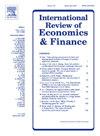中国人工林系统碳排放的脱钩效应及影响机制
IF 4.8
2区 经济学
Q1 BUSINESS, FINANCE
引用次数: 0
摘要
作为粮食生产和碳排放的重要纽带,种植业系统协同发展对实现中国“双碳”目标具有战略意义。全面评估这些维度之间的脱钩状况及其驱动因素,为发展中国家实现可持续发展目标2(零饥饿)和可持续发展目标13(气候行动)的双重全球目标提供了重要参考。本研究采用分层混合生命周期评估(TH-LCA)对2000 - 2022年中国作物种植系统的碳排放进行量化,评估其解耦效应、机制和脱碳潜力。主要发现包括:首先,核心产区的排放量增加了5%,主要处于弱脱钩状态。其次,种植制度结构优化和清洁能源采用成为主要驱动因素,而劳动力配置效率正向调节排放。相反,规模扩张和能源强度惯性是系统性障碍。第三,情景模拟预测,在常规发展情景下,到2030年排放量将达到29771亿吨。相比之下,适度脱钩路径和深度低碳情景可将排放量减少至280.16 Mt和277.53 Mt,分别比CDS减少5.89%和6.78%。本研究为中国作物种植系统碳排放综合分析、增强系统弹性、促进协同发展提供理论框架和政策支持。本文章由计算机程序翻译,如有差异,请以英文原文为准。
Decoupling effects and impact mechanisms of carbon emissions in China's plantation system
As a critical nexus for both grain production and carbon emissions, the synergistic development of the plantation system is of strategic importance for realizing China's “dual-carbon” goal. A comprehensive assessment of the decoupling status and its driving factors between these dimensions provides critical reference for developing countries in achieving the dual global goals of SDG 2 (Zero Hunger) and SDG 13 (Climate Action).This study employs a Tiered Hybrid Life Cycle Assessment (TH-LCA) to quantify carbon emissions from China's crop cultivation system from 2000 to 2022, evaluating its decoupling effects, underlying mechanisms, and decarbonization potential. Key findings include: First, core production zones exhibited a 5 % increase in emissions, predominantly in a weak decoupling state. Second, structural optimization of cropping systems and clean energy adoption emerged as primary drivers, while labor allocation efficiency positively moderated emissions. Conversely, scale expansion and energy intensity inertia acted as systemic barriers. Third, scenario simulations predict that under the conventional development scenario, emissions will reach 297.71 Mt by 2030. In contrast, the moderate decoupling pathway and deep low-carbon scenario could reduce emissions to 280.16 Mt and 277.53 Mt, representing decreases of 5.89 % and 6.78 % compared to the CDS, respectively. This study provides a theoretical framework and policy support for comprehensively analyzing carbon emissions in China's crop cultivation system, enhancing system resilience, and promoting synergistic development.
求助全文
通过发布文献求助,成功后即可免费获取论文全文。
去求助
来源期刊
CiteScore
7.30
自引率
2.20%
发文量
253
期刊介绍:
The International Review of Economics & Finance (IREF) is a scholarly journal devoted to the publication of high quality theoretical and empirical articles in all areas of international economics, macroeconomics and financial economics. Contributions that facilitate the communications between the real and the financial sectors of the economy are of particular interest.

 求助内容:
求助内容: 应助结果提醒方式:
应助结果提醒方式:


